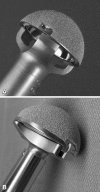Acetabular component thickness does not affect mid-term clinical results in hip resurfacing
- PMID: 24449332
- PMCID: PMC3971251
- DOI: 10.1007/s11999-014-3468-2
Acetabular component thickness does not affect mid-term clinical results in hip resurfacing
Abstract
Background: The benefits of using thin acetabular components for hip resurfacing have been shown in terms of bone conservation, but there currently are little data available in the literature addressing the mid-term clinical results of these devices.
Questions/purposes: We aimed to determine whether thinner acetabular components altered mid-term postoperative clinical scores, complication rates, survivorship, radiographic appearance, and metal ion levels.
Methods: Two hundred eighty-one patients with unilateral disease received a 5-mm thick acetabular shell and 223 received a 3.5-mm shell. The femoral component implanted in both groups was identical. We compared clinical scores, complication rates, survivorship, radiographic results, and ion levels between these two groups.
Results: UCLA hip scores were similar (pain, p = 0.0976; walking, p = 0.9571; function, p = 0.9316; activity, p = 0.2085). Complications were higher in the 5-mm group (6.4% versus 1.8%, p = 0.0431). Both groups were similar regarding survivorship (p = 0.3181), cup radiolucency at 5 years (p = 0.107), and metal ion levels (cobalt p = 0.404, chromium p = 0.250).
Conclusions: With comparable mid-term clinical results, there is no tangible reason to abstain from using the 3.5-mm acetabular component.
Level of evidence: Level III, retrospective comparative study. See the Guidelines for Authors for a complete description of levels of evidence.
Figures




Similar articles
-
Does femoral neck to cup impingement affect metal ion levels in hip resurfacing?Clin Orthop Relat Res. 2014 Feb;472(2):489-96. doi: 10.1007/s11999-013-3074-8. Clin Orthop Relat Res. 2014. PMID: 23690156 Free PMC article.
-
Are Females at Greater Risk for Revision Surgery After Hip Resurfacing Arthroplasty With the Articular Surface Replacement Prosthesis?Clin Orthop Relat Res. 2016 Oct;474(10):2257-65. doi: 10.1007/s11999-016-4860-x. Epub 2016 Apr 27. Clin Orthop Relat Res. 2016. PMID: 27121872 Free PMC article.
-
What Is the Rerevision Rate After Revising a Hip Resurfacing Arthroplasty? Analysis From the AOANJRR.Clin Orthop Relat Res. 2015 Nov;473(11):3458-64. doi: 10.1007/s11999-015-4215-z. Clin Orthop Relat Res. 2015. PMID: 25721576 Free PMC article.
-
Total Hip Arthroplasty After Acetabular Fracture Is Associated With Lower Survivorship and More Complications.Clin Orthop Relat Res. 2016 Feb;474(2):392-8. doi: 10.1007/s11999-015-4509-1. Clin Orthop Relat Res. 2016. PMID: 26335343 Free PMC article.
-
Metal-on-metal hip resurfacing in patients younger than 50 years: a retrospective analysis : 1285 cases, 12-year survivorship.J Orthop Surg Res. 2017 Jun 2;12(1):79. doi: 10.1186/s13018-017-0579-y. J Orthop Surg Res. 2017. PMID: 28578684 Free PMC article. Review.
Cited by
-
Current indications for hip resurfacing arthroplasty in 2016.Curr Rev Musculoskelet Med. 2016 Mar;9(1):84-92. doi: 10.1007/s12178-016-9324-0. Curr Rev Musculoskelet Med. 2016. PMID: 26830851 Free PMC article.
References
-
- Allan DG, Trammell R, Dyrstad B, Barnhart B, Milbrandt JC. Serum cobalt and chromium elevations following hip resurfacing with the Cormet 2000 device. J Surg Orthop Adv. 2007;16:12–18. - PubMed
-
- Amstutz HC, Beaulé PE, Dorey FJ, Le Duff MJ, Campbell PA, Gruen TA. Metal-on-metal hybrid surface arthroplasty: surgical technique. J Bone Joint Surg Am. 2006;88(suppl 1):234–249. - PubMed
Publication types
MeSH terms
LinkOut - more resources
Full Text Sources
Other Literature Sources
Medical
Research Materials

